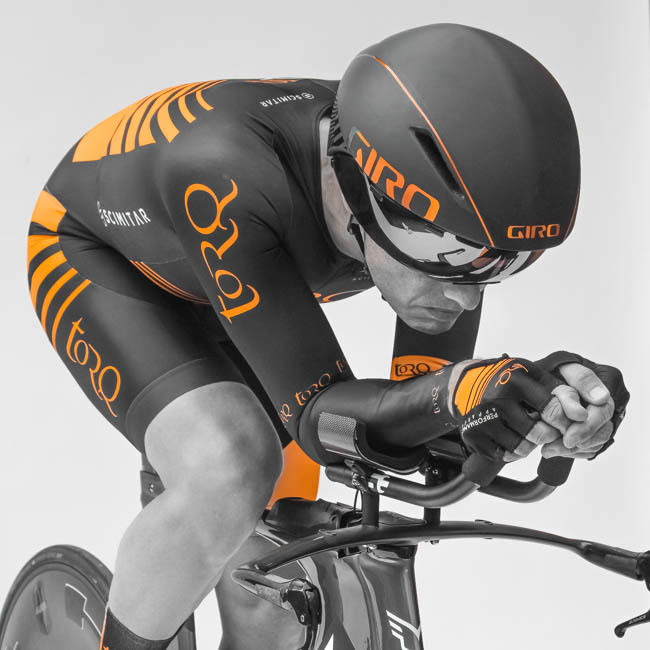With a lifelong passion for cycling and a background in road racing, Mark first approached TORQ several years ago for some training and nutritional advice. Having received coaching and nutritional guidance for a number of years through TORQ’s Fitness Consultancy, Mark has now chosen to take a significant step forward with his endurance goals by tackling the RTTC National 24-Hour Championships.
About Mark
When we first met Mark, his intention was to switch to long distance time trialling, so we have worked closely with him to develop training and a feeding strategy to suit these particular requirements. Progression has been good and 2017 was a great year for Mark, with several wins and personal bests at 50 miles – 1h38m, 100 miles – 3h21m and 12 hour – 312miles, which was good enough for an eventual 4th place in the prestigious British Best All Rounder competition. In addition to racing, Mark supports local road safety groups, petitioning for improved cycling infrastructure in the Peak District area and is a regular working guy.

About the Event
The RTTC National 24-Hour Championships on 20th July is the one that matters. It’s an opportunity for Mark to test himself against the best in the country and since the best in the UK seem to be the best in the World at this discipline, it’s fair to say that this event has significant kudos. How will Mark perform? He will be riding his own race, dealing with his own demons and using a very well structured nutritional plan (which we’re going to tell you all about), so all we have to say is that we wish him the best of luck!
You will be able to follow Mark’s progress blow-by-blow on our Twitter feed at @TORQfitness – his start time is 14:20 on Saturday 20th July.

24-Hour Racing
I’m sure that for many of us, the concept of racing over a 24-hour period with no sleep seems completely loopy! Well, as crazy as it sounds, it’s actually quite a popular thing and TORQ have a vast amount of experience in advising and coaching athletes to complete these events, primarily in the sport of Mountain Biking. We also attend and sponsor many 12 and 24-hour Mountain Biking events, including Twenty Four 12 and TORQ in Your Sleep, as well as the legendary Thunder Run – the sell-out 24-hour running event.
This article, we hope, will serve as a useful resource to anyone considering entering a 24-hour race, whatever discipline it might be in. There is a level of uniqueness to 24-hour racing on a road bike, the challenge that faces Mark, because of its unique physical and psychological demands. There are no technical off road sections or twists and turns that require quick thinking, which provide dare we say it, entertainment! The discipline requires pure unadulterated long-term focus and suffering – and if you think riding a bike for 24 hours is going to be hard, just consider the notion of racing it in an aero position!
If we can communicate a nutritional plan that serves to fuel the motivations and engine of someone partaking in the most intense form of 24-hour racing there is, it simply has to work for every other discipline. Our plan involves providing all of the necessary nutrients for an optimal performance, but layering the product/food choices in a way that will provide a psychological edge – something that will not just fuel the muscles, but also massage the mind.

The Principles of Performance Nutrition
As well as nailing down an effective nutritional strategy for race day, your nutritional intake and training effectiveness are hugely intertwined, which is why we separate training and racing nutrition here. It stands to reason that progressively overloading the body with harder and harder training sessions is going to bring about change and adaptation (the training effect). However it also stands to reason that if you don’t put the correct type and number of calories into your body, you won’t have the energy to progress or the raw materials to make the repairs and therefore adapt. Hence, your nutritional intake during training is fundamental to your physical preparation for the event itself. You’re wanting to be on that start line in the best possible form and that will come from effective, progressive, well-balanced training – and that requires effective, progressive, well-balanced nutrition.
Once you’re on the start line, feeling perfectly prepared and in the form of your life, what’s going to happen if you don’t get your fuelling right? You could have the most amazing form in the world, but you’ll get beaten by someone much less fit and physically prepared than you if you don’t optimise your race day nutrition and they do. Think of it like this – which car’s the fastest over a 24 hour period, a Le Mans 24-hour race car or a 1-litre family hatchback? It’s pretty obvious isn’t it? How about we feed you a little bit more information. What if the Le Mans car starts the 24-hour race with one full tank of fuel and when it’s gone it’s gone and the family hatchback is allowed to refuel as many times as it wants – who’s going to win the 24-hour race? The human body is no different – it will store a limited amount of useful fuel and if you don’t constantly feed fuel back into it, it will stall, however big your engine!
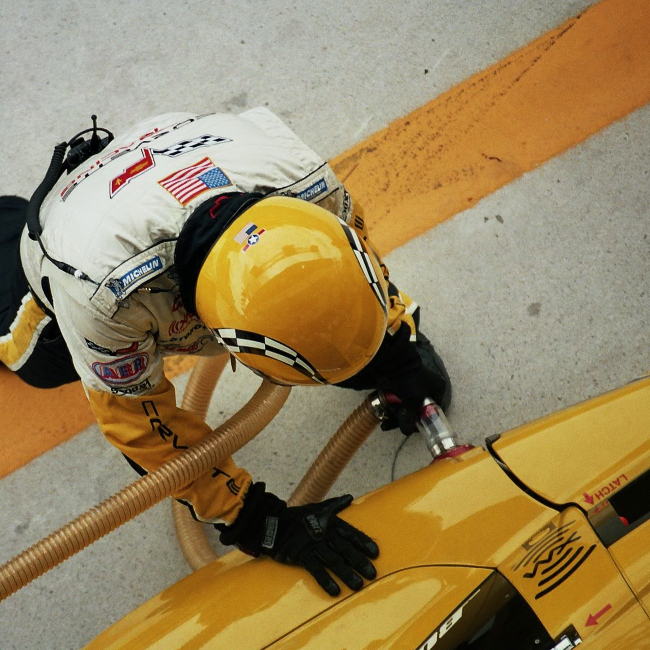
By understanding both your training and race nutrition, you can have the biggest engine possible at the start of your chosen event and the fuel to take it the distance. Yes, you can be the Le Mans 24-hour race car with all the fuel it could possibly need…
Fuelling Your Training
Fuelling your training and life in general outside of ‘race day’ involves following some very simple fundamental steps with your general nutrition. Nutrients are typically categorised into two camps, the ‘Micronutrients’ and the ‘Macronutrients’.
Micronutrients include the smaller items like vitamins and minerals. These nutrients really are the glue that holds everything together and must never be ignored, so however hard you’re training, you must always make an effort to consume fresh fruit and vegetables regularly throughout the day. These foods can easily be ignored, because they don’t hold the calorie density craved for when training hard, yet they contain compounds that will stop you getting sick and that help to build the cellular chemistry behind your great performances. If you ignore them, your body will ultimately buckle under the strain, which will clearly cause a major setback in your overall training goals. Fresh fruit and vegetables also contain high levels of dietary fibre, which although essentially calorie-free, is vital for intestinal health – pretty important if you’re wanting to absorb nutrients through it on a regular basis and under exercise stress. From a health perspective, fibre is vitally important and this article from the BBC News website explains how increasing our fibre is the single biggest favourable health adjustment we can make.
Macronutrients include Protein, Carbohydrate and Fat. These nutrients are the large energy-rich nutrients responsible for the vast majority of the body’s functions, the Micronutrients being much more subtle in their behaviour. Protein is the main building block of the human body and is the primary component of muscle tissue and other vital organs. Protein is also an essential component of many enzymes and hormones. Modern research suggests that any more than a 25 gram ingestion of protein at a time is wasted and that athletes should consume a 20-25 gram dose every 4 hours or so (5 to 6 times per day). This ensures that sufficient protein is circulating in the blood at all times to do the work the body may be asking of it. There are a whole variety of products on the market nowadays which advertise that they contain this magic 20-25 grams of protein, so this shouldn’t be too difficult to organise supplies. Alternatively, look at regular foods and make sure that you consume meals/snacks regularly containing sufficient protein.
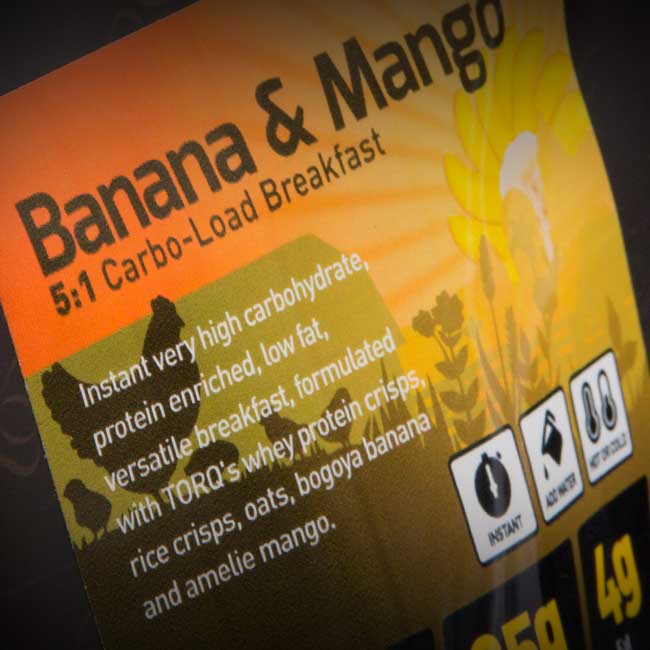
At TORQ we produce a variety of breakfasts and meals which contain precisely 25g of high quality protein and depending on the amount of activity you are doing on a particular day, you can choose a ratio of Carbohydrate:Protein to suit your energy output. TORQ meals and breakfasts range from 2:1 to 5:1 Carbohydrate:Protein, but the protein component is always 25g. We’re not for a moment suggesting that you should consume our TORQ meals and breakfasts all the time, but they can help when you’re busy or know that the quality of food you might get on the road is likely to be poor. They are very useful tools to help you get the job done. For further information, click HERE.
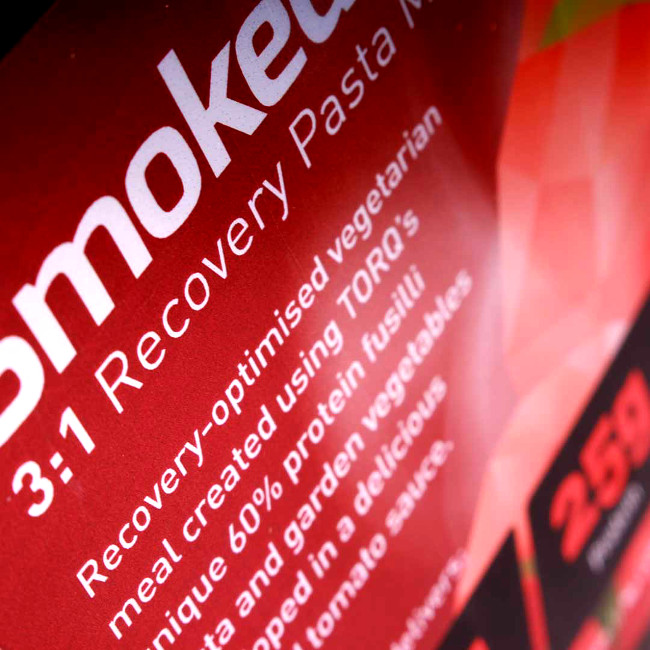
Whilst protein essentially forms the structure of the engine, carbohydrate is the primary fuel source to drive it. Fat is also an important fuel source, which we will discuss shortly, but carbohydrate is the muscle’s preferred fuel (it’s more instantly available) and unlike fat, it’s held in limited supply in the human body, so it can easily run out. The human body can store around 500g (2,000 calories) of carbohydrate in the muscles and liver. This is called ‘Endogenous Carbohydrate’ and if these stores are full, your exercise session will feel great. If they are low or run out, your exercise performance will drop off a cliff. In cycling , this cliff-drop is commonly referred to as ‘Bonking’. It’s a very unpleasant debilitating feeling and any dreams of a great performance will be for the birds.
The secret to completing successful endurance training involves improving your body’s ability to burn fat, because this isn’t held in limited supply like carbohydrate, beginning your sessions with full stores of carbohydrate and fuelling with what’s called ‘Exogenous Carbohydrate’ during your exercise. Exogenous carbohydrate refers to external fuel sources like energy drinks, gels, bars and chews. The way you train and periodise your nutrition will ultimately determine how much fat you are able to burn and this has been covered comprehensively in our Fasted Training or ‘Training Low’ article. In addition to this, if you want to keep your endogenous carbohydrate stores fully loaded, you will need to make sure that you consume plenty of carbohydrate-rich foods like pasta, rice, potatoes, bread, cereals and pulses. Don’t shy away from sugars either, especially when you’re training hard, because you will need the energy from them. If you want to go natural, use honey, agave syrup or molasses. It’s worth noting that if you add honey to a piece of toast, you literally double the carbohydrate content of it and toast with honey on it is much easier to eat than without. Not great if your aim is weight loss, but ideal if you’re training hard and need to re-stock your glycogen stores.
Once you’ve optimised your nutritional intake outside of your exercise and filled your endogenous stores, you need to look at your exogenous fuelling – the carbohydrate intake you implement during exercise. When you consume carbohydrate outside of exercise, you store it as glycogen – remember, you can only store up to 500grams and then any excess carbohydrate gets stored as fat. When you consume exogenous carbohydrate during exercise in the form of energy drinks, gels, bars or chews, you burn this carbohydrate directly and it isn’t stored. The principle of fuelling during exercise is therefore quite obvious if you think about it – you’re providing an alternative source of carbohydrate to burn other than your endogenous stores – your endogenous glycogen stores therefore run out later. The next logical assumption is that the more exogenous carbohydrate you consume during exercise, the more of a ‘sparing’ effect this has on your stores and this process is termed ‘glycogen sparing’.

There are some significant benefits to be gained from fuelling during training, because empty glycogen stores take a long time to top back up. Even on a high-carbohydrate diet, research suggests it’s about 48 hours for full replenishment, so if you can spare your glycogen by fuelling properly during exercise it stands to reason that you’ll recover your endogenous stores more quickly afterwards. If your stores recover quicker, you can train hard again sooner and your fitness will progress faster.
Unfortunately it’s not as simple as consuming bucket loads of carbohydrate during exercise to prevent endogenous glycogen depletion, because there are absorption limits dictated by carbohydrate transporters in the intestinal wall. If you are consuming glucose based energy products, the limit to absorption is around 60 grams per hour. If you think fuelling on jelly babies is a good idea, these are made with normal sugar and absorption is once again limited to around 60 grams per hour. Normal sugar is 50% glucose and 50% fructose. The science is that glucose is transported by a carrier called SGLUT1 and fructose is transported by a carrier called GLUT5. SGLUT1 maxes out at 60 grams per hour and GLUT5 maxes out at 30 grams per hour. Whichever way you look at it, glucose-only formulations are limited to 60 grams per hour by SGLUT1 and sucrose formulations are limited to 60 grams per hour by GLUT5. The only way to get higher absorption rates than 60 grams per hour is to somehow combine glucose and fructose in a 2:1 ratio so that both carriers are saturated, resulting in 90 grams carbohydrate delivery per hour. This research has been supported by over 20 peer-reviewed published studies since 2005 and time and time again it has been proven. It’s pretty logical when it’s explained properly isn’t it – give the glucose transporter what it needs and give the fructose transporter what it needs. Suffice to say, all of TORQ’s Fuelling System Products are based on this 2:1 dual-delivery of glucose derivatives and fructose. Hopefully you can understand why this kind of research is fundamental to your success, not just in your training, but in the event itself, which will be discussed shortly.
If you want to learn more, or have the concepts explained clearly with the help of infographics, please take the time to watch this video:

The last Macronutrient to discuss is fat. Fat contains essential material to support cell membrane structures, hormones and to provide a vital fuel source for endurance activity. It also contains fat-soluble vitamins A, D, E and K. That said, any over-consumption of carbohydrate or protein calories are stored as fat, so there’s a strong argument to keeping fat intake relatively low and maximising the intake of other calories, which if not useful for other processes, can be stored as fat anyway. Omega 3 is a fat and essential oil which is disturbingly overlooked in western societies. As a population our ratio of Omega 6, which is more abundantly available, to Omega 3 is really distorted and the upshot of it is that we should be looking to consume more sources of Omega 3 whilst reducing our intake of other more common fats. Good sources of Omega 3 include oily fish including salmon, walnuts, chia seeds and flax seeds to name a few. Do some research and start the hunt. You should only need to hunt for Omega 3 sources, there’s certainly no need to hunt for fat in general.
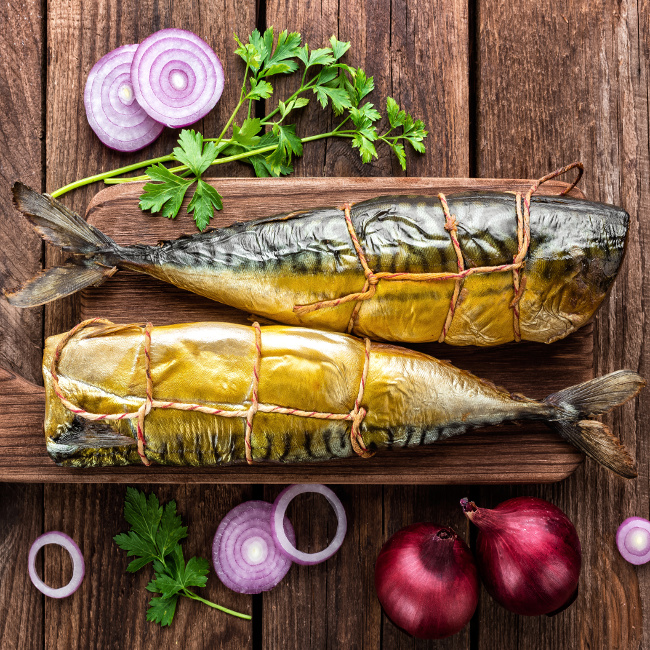
So, if we burn fat as a fuel during exercise, why don’t we consume it during exercise? The answer’s simple – it’s just as easy to mobilise fat to burn from our bodily stores as it is to burn dietary fat directly, so what’s the point? When we know that carbohydrate is held in limited supply, why would we need to even think about supplementing with fat? Also, fat dramatically slows down the absorption of carbohydrate, so if you were to consume it during exercise, not only are you putting in an irrelevant fuel, you’re slowing your essential carbohydrate absorption to a crawl. There may be some clues here as to what you shouldn’t be consuming during your race perhaps? All will be discussed.
Regarding hydration, dehydration will not help your performance and chronic dehydration could be very dangerous, so you need to take it seriously. Make sure you replace the fluid and electrolytes you lose through perspiration. It’s a simple rule and one that requires variable action, depending on how high your perspiration rates are. If it’s a very warm day or you’re training indoors and perspiration rates are high, you will need to drink significantly more than if training in cooler conditions. Consuming fluid through a good energy drink makes the most sense, since a proper energy drink will contain water, all 5 electrolytes and carbohydrate. The carbohydrate will actually facilitate the hydration process and will also provide a valuable exogenous fuel source as discussed above. TORQ have devised the TORQ Fuelling System to simplify the fuelling and hydration procedure and it’s very straight forward and logical. It’s vital to understand that a functional hydration drink will also contain fuel. Take the time to watch this short video to understand how the TORQ Fuelling System works:

Recovery From Your Training
There are some simple processes to consider in the recovery process. Your general diet is healthy, containing plenty of fresh fruit and vegetables, so you’ve got the Micronutrient glue to hold everything together. You’re consuming 20-25 grams of protein 5 to 6 times per day, so you’re providing the building blocks for adaptation. Your diet is rich in carbohydrate and you’re fuelling your exercise sessions to protect your endogenous stores. Your fat intake is relatively low, but you’re ensuring that you consume Omega 3 rich foods. What more can you actually do? In reality there isn’t much, however a well-timed recovery drink within 15 minutes of exercise completion would be a good idea, because the enzymes responsible for endogenous glycogen storage are highly active within this post-exercise window. You actually have a bit longer than 15 minutes, but ‘within 15 minutes’ is always a good target to make sure you get the job done. It’s also a good time to take on board 20-25 grams of high quality protein and funnily enough, that’s what a good recovery drink will give you. Research suggests a 3:1 ratio of carbohydrate to protein, ideally whey protein like in TORQ Recovery Drink, although if you’re vegan, pea protein is exceptional and TORQ do produce two Vegan Recovery Drinks. A recovery drink will also contain a good amount of fluid to aid the rehydration process. In the case of TORQ, we also include the powerful micronutrients Ribose and Glutamine in our recovery drinks, which we discuss briefly at the end of this article.
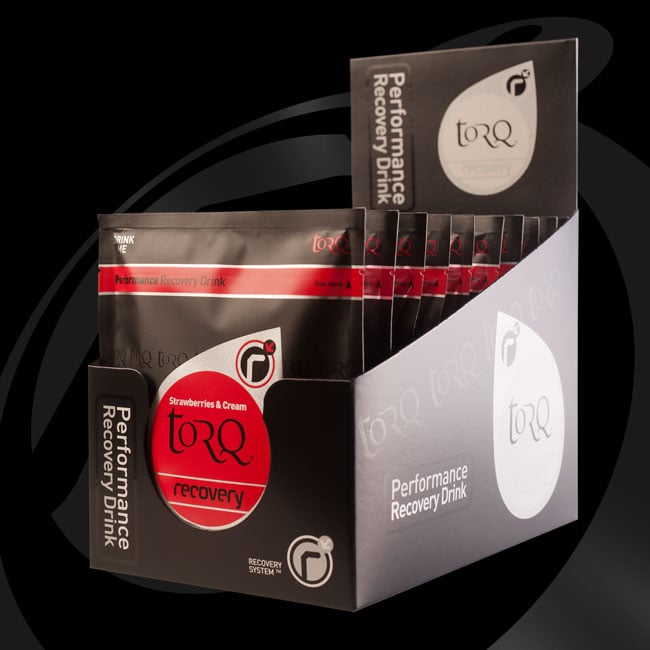
Pre-Race Nutrition
Preparing nutritionally for the big day starts around 24 hours prior to the start of the race. Your training should have tapered so that you’re doing very little exercise at all, so you’ll be peaking nicely. Your final preparation involves a simple but highly effective carbohydrate loading regime. 24 hours prior to the start of your event, jump onto your bike and pedal to a flat piece of road, or slight hill that’s going to give you enough space to ride hard for 3 minutes without stopping. Alternatively, you could do this on a turbo trainer or exercise bike. Warm up for 5 minutes and then produce one all-out 3-minute effort as hard as you can, producing as much lactic acid as you can possibly tolerate. Immediately afterwards, consume a recovery drink whilst spinning your legs gently and then for the rest of the day ‘load in the carbs’. Eat everything and anything, but think ‘carbs’ so when you’re bored of the starchy carbohydrates, eat a bag of wine gums. Don’t forget your regular intakes of protein, but carbohydrate is king for today. Don’t forget to have one last high carbohydrate feed before you go to bed and that’s essentially your pre-race nutrition nailed down. The table below shows a suggested carbohydrate loading regimen for a 62Kg person:
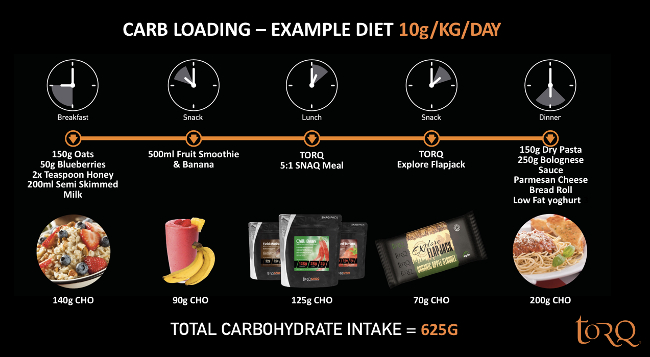
What you do in the morning will depend on the start time of the race, but assuming the event starts at midday, you should have a substantial breakfast at 9am containing 20-25 grams of high quality protein and a decent hit of carbs (up to 125 grams). This will restore any glycogen lost from the liver overnight as you’ve slept. Make sure that you have protein in your breakfast and that the overall feed is substantial, because you want to remain satiated right up until the start of the event – at the same time, you don’t want to be full on the start line, because you’re going to need to start fuelling as soon as you set off and need to leave room for the exogenous carbohydrate to do its work. Be sure to keep your fat intake minimal on race day morning, or you’ll still be digesting your breakfast on the start line. If you’re starting later in the day like Mark (he’s starting at 14:20) remember to keep the protein going in every 4 hours or so and don’t get hungry. Maintain the ingestion of high carbohydrate, low fat foods throughout the morning.
Fuelling Your Race
Now there are two ways of looking at this. There’s what the text book says you should do and there’s what is practical and achievable for you personally and the two may be the same, or they could be very different.
There are a few nutrition fundamentals though, so let’s cover those. Firstly, anything you eat MUST be low in fat. Dietary fat is the enemy to the endurance athlete and as we’ve previously explained. Just because you’re going to be burning lots of fat whilst you ride, it doesn’t mean you should be consuming it in your food! Secondly, for reasons also previously mentioned, you will need to consume carbohydrate to provide exogenous fuel. Protein is an interesting variable, because although in an ideal world you’d be getting 20-25 grams of protein every 4 hours or so, this amount of protein intake would have a detrimental effect on carbohydrate uptake and is highly likely to be converted to carbohydrate anyway at an energy-cost to your body because of the demand for fast-burning fuel. So, for the purposes of ultra-endurance racing, cut protein intake back to one 20-25 gram feed per 8 hours of racing with perhaps a smaller protein 15g feed at 4 hours.

For a 12-hour event, you could feasibly get by without consuming any protein, but this is where text book and reality arms wrestle a bit. We know of top level 24-hour athletes who have won races consuming 60-90 grams of carbohydrate per hour using TORQ Products and have literally fuelled by the book with minimal protein intake. We know of other athletes who just simply couldn’t tolerate such a rigid inflexible approach and needed to adapt their nutrition to fit in with a personal system they were capable of maintaining. If moving away from the text book optimum enables you to maintain concentration and positivity in such an extreme event, surely this would be better than persisting with the text book approach, being miserable and emptying the contents of your delicate stomach?
In practical and realistic terms, use the text book approach of 60-90 grams of carbohydrate per hour via 2:1 sources as the ‘holy grail’ and then produce a nutritional plan punctuating the period of the race with sensible alterations. Remember that all of these alterations are ‘low fat’ alterations, so if you’re going to insert a savoury protein snack into your plan, don’t go for cheese or peanut butter, because they are high fat protein sources. Go for lean ham, or a bacon sandwich with the fat cut off. No butter on the bread – tomato ketchup is fine with the bacon, or you could use sweet pickle or mustard instead of butter with the ham sandwich. A recovery drink contains protein and carbs and will offer a nice texture change, so consider downing one of these in the pits and then taking a bottle of plain water out on the next lap whilst it digests. Anticipate what you’re likely to be craving, but follow the rules and don’t make any fundamental mistakes.

Be wary of the people who claim to be experienced 24-hour racers who say ‘I just do the whole thing on cheese and black coffee and it works for me’. If they win on cheese and black coffee, perhaps they’ve got a point, but participating and consuming cheese and black coffee is a very different thing to competing. ‘It works for me’ is meaningless unless you can get them to define what ‘works for me’ means? There are all sorts of ‘works for me’ fads out there which might get them around, but if they prepared and actually got their nutrition fundamentally correct, they’d do a whole lot better guaranteed. You will also have people suggest that you should be eating ‘real food’. The problem is that ‘real food’ is entirely subjective and if you don’t pay enough attention, you could slip into the cheese and black coffee trap. It has been scientifically proven that real food isn’t the optimal way to fuel, but an extreme event like 24-hour racing does warrant some special psychological consideration. In the previous paragraph you were given some perfectly respectable ‘real food’ choices, so schedule these in to your race plan, but don’t have any real food available in the pits to use as an emotional crutch – replace it with a food that will satisfy the savoury craving you might have, but fits the ‘rules’.
There’s another golden rule. Sometimes you just over-consume on calories or you get the fluid/carb balance wrong – it just happens and you’ll feel pretty unwell! Perhaps your perspiration rates were higher than expected and you took a gel when you should have necked another 500ml bottle of energy drink instead? Whatever the reason, there’s a fix and it’s called ‘plain water’. No gels, no bars, no lean bacon sandwiches and no energy drinks, just plain water. Stay on the plain water until you start to feel better and wait until you suddenly become ravenously hungry – at this point, you can resume your fuelling and carry on as if nothing happened.

Once again, please take the time to look at the TORQ Fuelling System in more detail, understand it and implement it into some of your longer training rides. Make adjustments if necessary and formulate a clear nutritional plan and stick to it. You may have to deviate onto plain water one or two times during the event, but essentially the plan is there, you’ve practiced and you know it works.
Mark’s Nutritional Race Plan
We’ve discussed the fundamentals above, but let’s look at this real life example and what we’re suggesting Mark should actually do. Mark is experienced at consuming 90 grams of carbohydrate (3 TORQ Units) per hour and this is vital to establish at the outset. The gut is a trainable organ and you can’t simply start throwing large amounts of carbohydrate at it and expect it to do the job without some rehearsal time. Get used to taking carbohydrate calories on during training and if you are going for the optimal 90g per hour strategy, make sure you’ve had a dry run in anger over a long distance so that you’re confident you can handle it. 60g (2 TORQ Units) of 2:1 formulations will work well with everyone, because it’s 40% below the intestine’s absorption threshold, but pushing to the higher levels needs to be planned.
So, Mark is going to stick to the TORQ Fuelling System and 90g (3 TORQ Units) per hour from the moment he starts, consuming his first 30g (1 TORQ Unit) on the start line 1 minute before he sets off. This will give his muscles some exogenous carbohydrate to burn right from the gun, immediately sparing his stored endogenous carbohydrate. He will then continue to follow the TORQ Fuelling System at 3 TORQ Units per hour.
Mark is planning two scheduled stops at 8 hours and 16 hours where (as well as having a good stretch) he will take on a 25g protein feed and will have a choice of a TORQ Recovery Drink, TORQ SNAQ 3:1 Cinnamon & Raisin Breakfast or TORQ SNAQ 3:1 Smoked Tomato Pasta Meal. All will essentially do the same job, but after such a large amount of riding it is going to be difficult for Mark to predict what he will feel like eating. All of these choices will supply similar nutritionals, so he just needs to choose what he fancies at the time. Once consumed, Mark will consume water only for the following hour and won’t consume any TORQ Fuelling System products unless his body starts asking for them. This is because with his 25g protein feed, he’ll also get 75g of carbohydrate and he needs to give his body chance to absorb this. If your personal feed choice were to be a lean ham sandwich for instance, you would want to make sure that you got 20-25g protein from it, but your body would start asking for fuelling products sooner, because the carbohydrate in the bread would be significantly lower than 75g. Mark is vegetarian, hence the choices we’ve opted for.
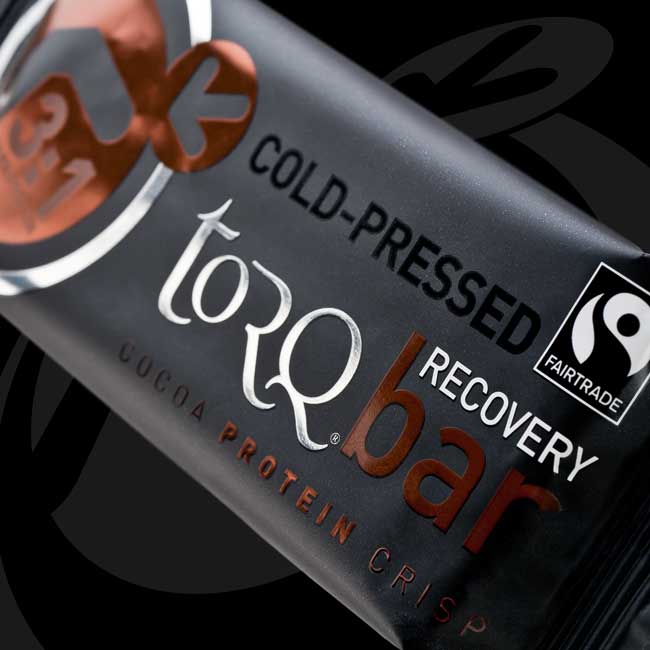
In addition to these 2 scheduled stops, Mark will be handed up either a TORQ Recovery Bar or a small TORQ Recovery Drink, each containing around 15g of protein at 4, 12 and 20 hours. The 4 hour protein feed is likely to be a Recovery Bar and at 12 and 20 hours, a Recovery Drink, because it will be easier to consume. Again after the protein feed, Mark will consume plain water again, but this time for just 30 minutes and then he’ll move back onto the TORQ Fuelling System.
So, with the TORQ Fuelling System, which products is Mark going to use? Hopefully by this point in the article, you understand how the system works, but just as a reminder, the diagram below illustrates how Mark’s choices will be affected by environmental conditions and perspiration rates.
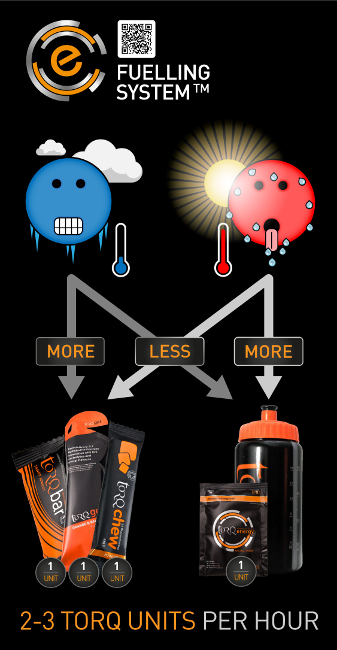
Therefore, the approach we’ve decided to follow is that if conditions are cooler (below 25 degrees C), Mark will be consuming around 500ml TORQ Energy Drink per hour and consuming a concentrated TORQ Fuelling Unit every 30 minutes to provide his 3 TORQ Units per hour. If temperatures move above 25 degrees, he will continue to consume a concentrated TORQ Fuelling Unit every 30 minutes, but use TORQ Hypotonic Drink instead. TORQ Hypotonic contains half the carbohydrate of TORQ Energy Drink, but the same concentration of electrolytes and this means that he can consume 1 litre per hour for hydration purposes, but still only be consuming 1 TORQ Unit. In summary, 500ml of TORQ Energy Drink = 1 TORQ Unit and 1,000ml of TORQ Hypotonic = 1 TORQ Unit.
It could be possible that temperatures result in high perspiration rates during the day and then reduce at night, so Mark’s team will need to move him from TORQ Hypotonic to TORQ Energy as the sun goes down. There are other ways to go about this and Mark could consume 1 litre of TORQ Energy per hour and 1 concentrated TORQ Unit and have exactly the same effect, it’s just that we consider this strategy of a concentrated fuelling unit every half an hour without fail easier to manage and better psychologically for Mark – the more decisions that are made prior to the competition, the more he can concentrate on the task at hand.
Mark will be using a variety of flavours in the TORQ drink range, which will include TORQ Energy Vanilla, a product we designed specifically for the rigours of ultra-endurance events. This drink tastes like watery ice cream and is almost savoury on the palate – a revelation when all else you have been consuming has been sweet and fruity.
With regard to the concentrated TORQ Fuelling Units, will Mark be eating gels, bars or chews? The answer is that he will have a mixture of everything to create variety. All of the fuelling units will do the same job, so it actually doesn’t matter which ones he consumes, but we have worked out a nice little system to help with the psychological demands he will be enduring. We asked Mark which were his favourite products and although he’s very easy to please and says he likes them all, we singled some out that we considered to be ‘special’ and we have scheduled these for ‘special hours’ to help him keep focus and turn his grimace into a little smile. So during hours 4, 8, 12, 16 and 22 he will be having Cherry Bakewell gels and/or Organic Mango bars. If he feels like having 2 gels, he’ll leave the Mango bar, but every 4 hours or so will be his finest hour.
Also, he loves the Caramel Latte gels too and as these have the added benefit of caffeine delivery, this gel will be the first fuelling product he has after a protein feed, which will complete his fuelling cycle for hours 6, 10, 14 and 18. He will also take one at the start of hours 23 and 24 to bring him home. This will give him a total of 6 caffeine injections over the 24-hour period.
All other fuelling will be via a random mixture of TORQ’s great flavours. The table below shows what we’re aiming to achieve through this feeding strategy. NOTE: For clarification, a protein feed after 4 hours of riding will take place at the start of hour 5.
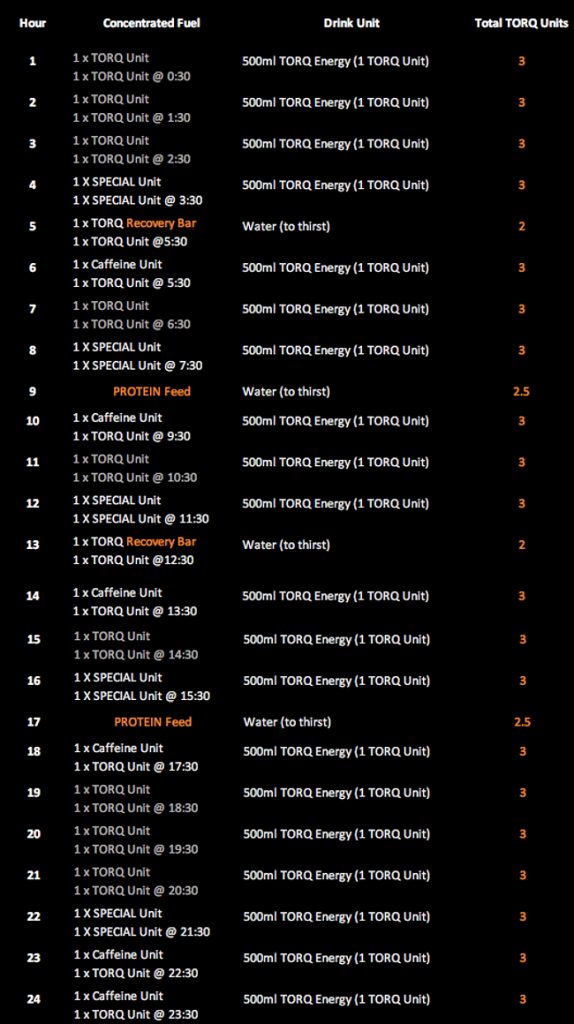
Post-Race Recovery
Do you know what? We could advise you to consume a recovery drink within 15 minutes of finishing the event and you may feel better for it for the rest of the day, but at the same time there are no hard and fast rules when it comes to recovery from such an epic effort. You will have achieved so much and if you’re not allowed a beer and a bar of chocolate after doing that, then the world just isn’t a fair place! In reality, your recovery is going to take days, perhaps weeks, so enjoy the post event euphoria and then get yourself onto a healthy balanced diet with very little exercise to help your physiological systems recover. Plenty of fresh fruit and vegetables to glue everything back together and listen to your body – you’ll be able to feel when you’re good to go again.
Supplements
There are a few additional supplements that we’d like to mention here to help you on your way to ultra-endurance success. As you will have gathered, fuelling your training and event isn’t rocket science, you just need to stick to the solid principles outlined and work with them. There are however three supplementary nutrients you might want to consider using:
Caffeine: We have already discussed this, but there is an enormous amount of evidence supporting the benefits of caffeine ingestion on sporting performance. The effects are often more pronounced after a period of abstinence, so backing off on the tea, coffee and other caffeinated beverages for the weeks leading up to the event and reintroducing it moderately during your race should prove beneficial, specifically during the night when staying awake and lively is of paramount importance. To view our range of naturally caffeinated (with guarana) gels, click HERE and scroll to the bottom of the page.
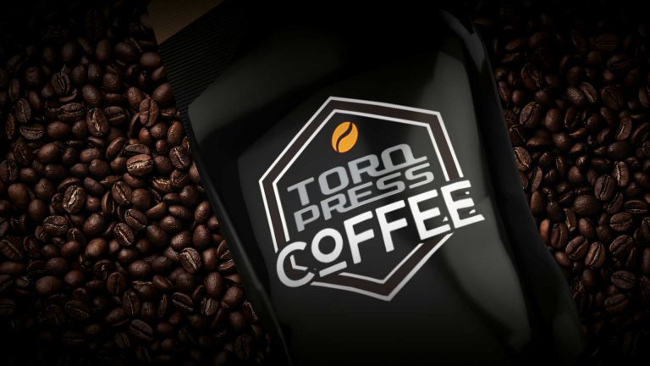
HMB: Otherwise known as Beta-Hydroxy-Methylbeutyrate. It’s a metabolite of an amino acid called leucine. Its naturally occurring within the body and is implicated in muscle and strength gain as well as protecting your muscles from being eaten or ‘catabolised’. It’s one of those supplements that works in the background rather like a super-protein assisting in building and protecting your hard-earned muscle fibres. Certainly a good one to take during the training build-up, but not advisable during the event itself. For more information on HMB, click HERE.
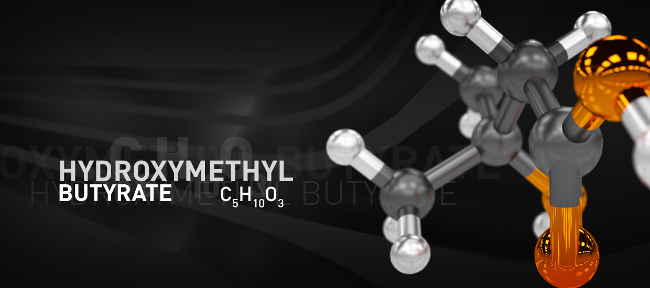
Ribose: Ribose is a 5-carbon sugar and once again your body manufacturers it in very small quantities, this time from glucose. Ribose possesses a number of qualities including hastening post-exercise recovery (which is why we use it in our recovery drinks at TORQ), but with regard to the ultra-endurance event itself, although the mechanisms are unclear, it also assists in preventing muscular cramping. We advise adding 3-5g of ribose to each 750ml drinks bottle during the event. This should not only stave-off cramping, but will also assist in a process we call ‘recovery on the hoof’ whereby doses or ribose taken earlier in the event will help combat fatigue in the muscles towards the closing stages of the race. We will be adding TORQ Ribose to Mark’s drinks.
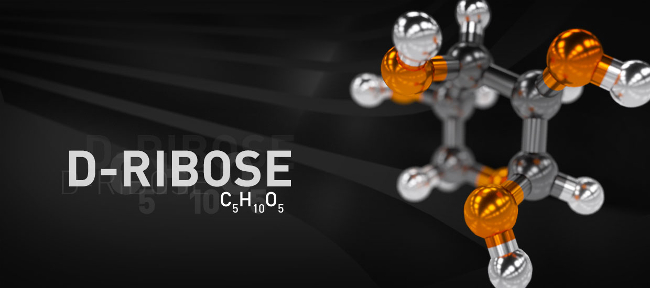
We really hope that you’ve found this article interesting and informative and a valuable resource to help you in your preparation for 24-hour racing, you crazy people!
For further advice on this topic or any fitness or nutritional queries, please don’t hesitate in getting in contact with us. We are happy to discuss your own situation over the phone/email on 0344 332 0852 // enquiries@torqfitness.co.uk or you could book in for Fitness Consultancy if you would like to formulate a bespoke plan like Mark’s.
